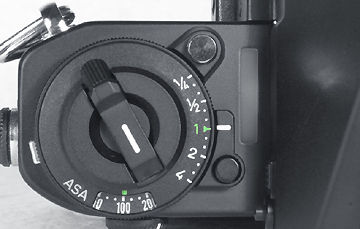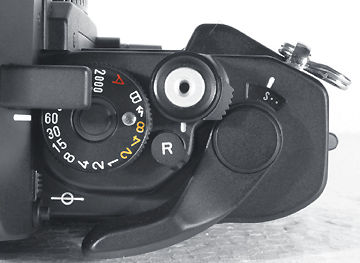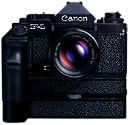Manual or AE body ? The
New F-1 is both !
I think Canon also has been struggling, facing the task of decisions concerned its
exposure control system on the New F-1during its early days of determining how should
the New F-1 handles the exposure control system. It is one of the major key element
in top level camera, which expect will have a eight to ten years business cycle,
these decision could made a lot of differences in term of corporate image, financial
return on investment and most of all, could spell success or failure in leading the
direction of future mid-range models for serious users. Should the New F-1 be an
fully AE camera, like the earlier Canon's successful "A" series? Or should
it follow the footsteps of the all mechanical F-1, strictly a manual camera? It was
finally determined that the New F-1 would be a manual camera, but with AE functions
available through system attachments. AE functions, because a professional sometimes
needs the versatility and shooting ease of automatic exposure. Manual, because professionals
know from experience that AE alone is not enough.
 |
Credit: Image courtesy of Mr. Claudio®. who is a collector for Canon photo gear, he also has an Ebay Section as well as maintaining a website on his own where occasionally trading some photo equipment. Image(s) copyright © 2003. All rights reserved. Please respect the visual property of the contributing photographer. |
Some key factors and valuable input from the users has obviously influenced Canon to take into consideration before the New F-1 was put on the drawing board. Factors where most people expect a top performance camera should be, like extreme accuracy, durability, usable even in the most extreme climatic conditions, yet versatile enough and silky smooth and trouble free operations. Of cause, the system intergration with other system components are equally important. These objectives resulted was a system that uses manual match-needle metering as a base, but includes AE possibilities for even greater flexibility. A mid way between the full AE like the A series cameras and with the backbone formed during the a decade long cycle of the F-1. But, realising the fact that most users, sometimes, a metering is essentially an important aid in fast and responsive photography, the metering side was given a big boost.
* Click Here
for the info page (If not, this page will be too long).
|
The New F-1 Exposure Control System |
|||
|
Finder attached |
Metering Mode |
New F-1 Body |
AE
Motor Drive FN |
|
Eye Level Finder FN |
Full aperture Metering | Match Meter manual | Shutter Priority AE Match Meter manual |
| Stopped Down Metering | Stopped Down manual | Stopped Down manual | |
|
AE Finder FN |
Full aperture Metering | Aperture Priority AE Match Meter manual |
Shutter Priority AE Aperture Priority AE Match Meter manual |
| Stopped Down Metering | Stopped Down AE Stopped Down manual |
Stopped Down AE Stopped Down manual |
|
Also check * AE chart for easier references
Normally, a camera with an easy-to-use exposure system has a single metering sensitivity pattern. Although a single metering pattern is quite sufficient for the average photographer, the demanding professional could not rely on one alone for more precise metering to ensure higher rate of return of successful photograpghs. Thus they have designed three different metering sensitivity patterns for a total of 32 different focusing screen/metering pattern possibilities. How was these possible ? The Nikon F3 and the Pentax (Both launched in 1980, a year a head) has seen and given the photo watchers a clue of how camera designers envisioned in exposure control. AE is a natural trend, metering was another - both Pentax and Nikon has a SPC cell laid under the main reflex mirror box and facing backward to the film plane to perform TTL OTF flash metering (Incidentally, copied and modified the Olympus's pioneered method). In a very surprise move, Canon didn't follow suit. Instead, they moved the SPC cell just under the eyepiece.
 |
Credit: Image courtesy of Mr. Claudio®. who is a collector for Canon photo gear, he also has an Ebay Section as well as maintaining a website on his own where occasionally trading some photo equipment. Image(s) copyright © 2003. All rights reserved. Please respect the visual property of the contributing photographer. |
| Next | More technical info is available at next Page
Instruction Manual: Canon New F-1 Camera | Motor Drive FN | Canon High Speed Motor Drive Camera |
Main Reference/Layout Map for body: HTML | PDF (471k)
Specifications: HTML | PDF (58k)
| Message Board |
for your New Canon F-1 SLR camera(s)
| Message Board | for your Canon optics
in a shared environment
| Message Board | Specifically for Dispose or Looking for Canon Photographic
equipment
| Back to Main Index Page | Canon New F-1 Website
Its
Concept, Its System
Metering Options,
Viewfinders, Exposures
Control, Reliability
Issues,
Shutter Mechanism; Motor Drives/Winder, Data Film
backs,
Flash photography, Focusing Screens, Macro/Close-up,
Remote photography.
Canon FD & FDn Lenses.
About this photographic site.
Home - Photography in Malaysia |
Copyright © 2000. leofoo ®. MIR Web Development Team.
Credit: Mr Richard Yeow, General Manager of camera and video division, Canon Marketing, Malaysia and Tony Kano, for being so supportive and granting permission to use some of the original content of Canon; Mr Philip Chong for patching some mistakes made earlier in this site. Made with a PowerMac, Broadcating with a RedHat Linux Server.


